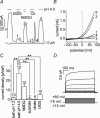Characterization of a proton-activated, outwardly rectifying anion channel
- PMID:15961423
- PMCID: PMC1474181
- DOI: 10.1113/jphysiol.2005.089888
Characterization of a proton-activated, outwardly rectifying anion channel
Abstract
Anion channels are present in every mammalian cell and serve many different functions, including cell volume regulation, ion transport across epithelia, regulation of membrane potential and vesicular acidification. Here we characterize a proton-activated, outwardly rectifying current endogenously expressed in HEK293 cells. Binding of three to four protons activated the anion permeable channels at external pH below 5.5 (50% activation at pH 5.1). The proton-activated current is strongly outwardly rectifying, due to an outwardly rectifying single channel conductance and an additional voltage dependent facilitation at depolarized membrane potentials. The anion channel blocker 4,4'-diisothiocyanostilbene-2,2'-disulphonic acid (DIDS) rapidly and potently inhibited the channel (IC50: 2.9 microm). Flufenamic acid blocked this channel only slowly, while mibefradil and amiloride at high concentrations had no effect. As determined from reversal potential measurements under bi-ionic conditions, the relative permeability sequence of this channel was SCN-> I-> NO3-> Br-> Cl-. None of the previously characterized anion channel matches the properties of the proton-activated, outwardly rectifying channel. Specifically, the proton-activated and the volume-regulated anion channels are two distinct and separable populations of ion channels, each having its own set of biophysical and pharmacological properties. We also demonstrate endogenous proton-activated currents in primary cultured hippocampal astrocytes. The proton-activated current in astrocytes is also carried by anions, strongly outwardly rectifying, voltage dependent and inhibited by DIDS. Proton-activated, outwardly rectifying anion channels therefore may be a broadly expressed part of the anionic channel repertoire of mammalian cells.
Figures















References
- Accardi A, Miller C. Secondary active transport mediated by a prokaryotic homologue of ClC Cl− channels. Nature. 2004;427:803–807. - PubMed
- Ando-Akatsuka Y, Abdullaev IF, Lee EL, Okada Y, Sabirov RZ. Down-regulation of volume-sensitive Cl− channels by CFTR is mediated by the second nucleotide-binding domain. Pflügers Arch. 2002;445:177–186. - PubMed
- Auzanneau C, Thoreau V, Kitzis A, Becq F. A novel voltage dependent chloride current activated by extracellular acidic pH in cultured rat Sertoli cells. J Biol Chem. 2003;278:19230–19236. - PubMed
- Blaustein MP, Lederer WJ. Sodium/calcium exchange: its physiological implications. Physiol Rev. 1999;79:763–854. - PubMed
Publication types
MeSH terms
Substances
LinkOut - more resources
Full Text Sources
Research Materials